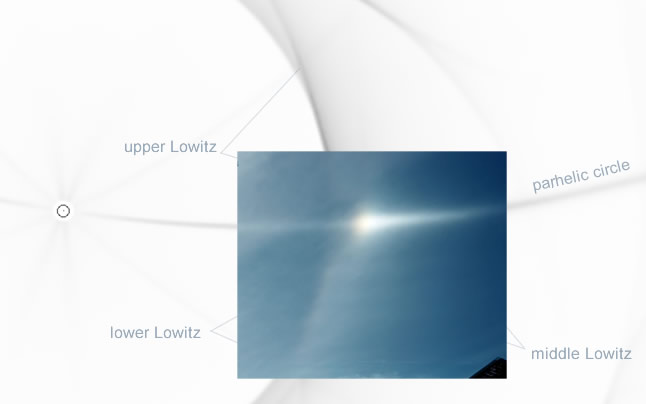| 1988 Lowitz Arcs - Dover, Delaware |
|
|||||
| Image processing: R. Eric Young of Young's Studio scanned Robert Gorkin's original negatives to 1800x1204 24bit TIFF files. Les Cowley mildly filtered the TIFFs to reduce film grain. The only further manipulation was to slightly adjust contrast and colour balance using the linear levels control in Photoshop. References: Lowitz, T., Nova Acta Acad Sci Imperialis Petropolitanae, 8, 384 (1794) Mueller J R, Greenler R G and Mallman A J., JOSA 69, 1103 (1979) and citations there. Greenler, Robert, "Rainbows, Halos and Glories", Cambridge, 1980 |
| When the sun is 15-30� high the best place to search for an upper Lowitz arc is above the 22� halo rather than near the parhelia. There, it crosses the upper tangent arc and becomes tangent to the Parry arc. Gorkin's images above (#19,#18 ) show the upper arc clearly. They also show arcs near each parhelion. |
| A bright and vertically elongated 120º parhelion to the east. The parhelic circle stretches sunwards. |
Robert Gorkin's notes of the observation written at the time in his day book and partly on the same evening. The display was notable enough besides the Lowitz arcs with an upper Parry arc, supralateral arc, circumzenithal arc and possibly a helic arc - an early recording of the latter. The parhelic circle extended around the sky to a bright 120º parhelion. |
| HaloSim ray tracing for 27º high sun overlain by three stacked images (#14-16). Mouse over the image to toggle it on/off. The simulation Lowitz crystals were regular hexagonal plates with classical Lowitz orientation i.e. full 360º positions about the Lowitz axis. The plates were thick (c/a = 0.5) to show up the middle Lowitz arc. The bright and tall 120º parhelion (lowest image) also suggests thick (or triangular aspect) plates. |
| 1988 Images. The earliest known images of complete Lowitz arcs. Robert Gorkin recorded the display at Dover, Delaware, USA on Tuesday, November 22, 1988 13:15 to 14:00 EST. At left is one of his 24 images recorded on two film rolls. At this time, and until the late 1990s and beyond, the existence of Lowitz arcs was controversial owing to a dearth of observations. In 1979, use of pioneering ray tracing methods by Mueller, Greenler and Mallmann predicted three Lowitz arcs, an 'upper', 'lower' and 'middle'. Gorkin's 1988 images are perhaps the earliest that show them. At top (#16) the lower Lowitz arc, the only one recorded by Lowitz, stretches down from the sundog towards the 22� halo. A fainter arc extends upwards to the 22� halo, the upper arc. In places these arcs overlay the 22� halo and their presence, as here, is often best indicted by weakness of the 22� halo near the parhelion. There is possibly a middle arc extending nearly vertically through the parhelion. It is slightly more evident in the stacked images at left. Mouse over for a ray tracing comparison. All images ©Robert Gorkin, shown with permission. |
 |

 |
 |
|